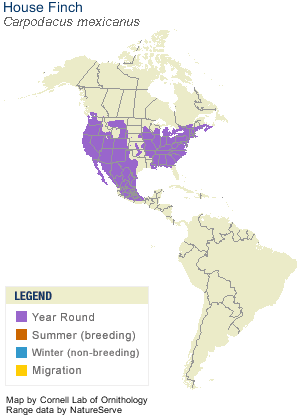Next to the House Sparrow the House Finch is the most frequent visitor to my backyard bird feeders. In spring I love to hear their melodious song in the tops of our neighborhood trees.
The House Finch is a recent introduction from western into eastern North America (and Hawaii), but it has received a warmer reception than other arrivals like the European Starling and House Sparrow. That’s partly due to the cheerful red head and breast of males, and to the bird’s long, twittering song, which can now be heard in most of the neighborhoods of the continent. If you haven’t seen one recently, chances are you can find one at the next bird feeder you come across.

Typical Voice
-
Size & Shape
House Finches are small-bodied finches with fairly large beaks and somewhat long, flat heads. The wings are short, making the tail seem long by comparison. Many finches have distinctly notched tails, but the House Finch has a relatively shallow notch in its tail.
-
Color Pattern
Adult males are rosy red around the face and upper breast, with streaky brown back, belly and tail. In flight, the red rump is conspicuous. Adult females aren’t red; they are plain grayish-brown with thick, blurry streaks and an indistinctly marked face.
-
Behavior
House Finches are gregarious birds that collect at feeders or perch high in nearby trees. When they’re not at feeders, they feed on the ground, on weed stalks, or in trees. They move fairly slowly and sit still as they shell seeds by crushing them with rapid bites. Flight is bouncy, like many finches.
-
Habitat
House Finches frequent city parks, backyards, urban centers, farms, and forest edges across the continent. In the western U.S., you’ll also find House Finches in their native habitats of deserts, grassland, chaparral, and open woods.




1 comment:
I wonder how well they deal with the unwanted starlings.
Post a Comment